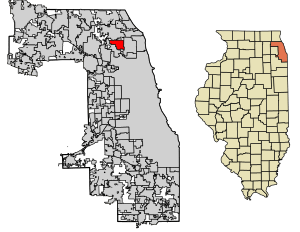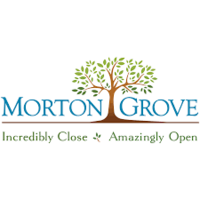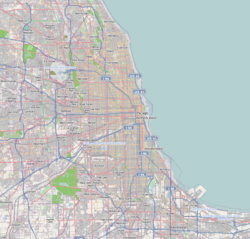Morton Grove, Illinois facts for kids
Quick facts for kids
Morton Grove, Illinois
|
||
|---|---|---|

Morton Grove Civic Center
|
||
|
||
| Nickname(s):
The Grove
|
||
| Motto(s):
"First in service.."
|
||

Location of Morton Grove in Cook County, Illinois.
|
||
| Country | United States | |
| State | Illinois | |
| County | Cook | |
| Township | Maine, Niles | |
| Founded | 1895 | |
| Area | ||
| • Total | 5.09 sq mi (13.18 km2) | |
| • Land | 5.09 sq mi (13.18 km2) | |
| • Water | 0.00 sq mi (0.00 km2) | |
| Elevation | 623 ft (190 m) | |
| Population
(2020)
|
||
| • Total | 25,297 | |
| • Density | 4,971.89/sq mi (1,919.60/km2) | |
| Time zone | UTC-6 (CST) | |
| • Summer (DST) | UTC-5 (CDT) | |
| ZIP Code(s) |
60053, 60054, 60055
|
|
| Area code(s) | 847 | |
| FIPS code | 17-50647 | |
| GNIS feature ID | 413865 | |
Morton Grove is a village located in Cook County, Illinois, in the United States. In 2020, about 25,297 people lived there. It is part of the larger Chicago metropolitan area.
The village gets its name from Levi Parsons Morton, who was once the Vice President of the United States. He helped fund the Chicago, Milwaukee and St. Paul Railroad. This railroad built a stop near an old sawmill called Miller's Mill. A road, now known as Lincoln Avenue, connected the sawmill to a nearby settlement. The railroad stop helped the area grow, and Morton Grove officially became a village in December 1895.
Contents
History of Morton Grove
Some farmers from England first settled in the area around 1830-1832. At that time, there were no roads from Chicago, only trails used by Native Americans. After the Black Hawk War and the 1833 Treaty of Chicago, Native Americans left the area.
Farmers from Germany and Luxembourg began arriving later in the 1830s. They cleared the land by cutting down many trees like walnut, oak, and maple. The wood was used for building and heating homes in Chicago.
Early Development
Around 1841, a man named John Miller built a sawmill powered by water near the Chicago River. This made it easier to build homes in the area. A road, first called Miller's Mill Road and later Lincoln Avenue, helped transport wood and farm products to nearby towns and Chicago.
In 1850, a road to Chicago, now known as Milwaukee Avenue, was improved. This made the journey to Chicago much faster, helping farmers sell their goods.
In 1872, the Chicago, Milwaukee and St. Paul Railroad bought Miller's Mill. They built train tracks and also dug for gravel nearby, creating a quarry. The train stop at Miller's Mill was named Morton Grove to honor Levi Parsons Morton, who helped fund the railroad.
The settlement of Morton Grove started growing. By 1874, it had its first postmaster. The village officially became a village on December 24, 1895. George Harrer, who was of German descent, became Morton Grove's first mayor.
Growth in the 20th Century
The first greenhouses were built in Morton Grove in 1885. The Poehlman Brothers' floral business became one of the world's largest flower companies. They even won an award at the 1904 St. Louis World’s Fair for one of their roses. Their business employed many people.
However, the Poehlman Brothers' business went bankrupt during the Great Depression. Later, Baxter Laboratories bought much of their land and became a big employer. Today, some floral businesses still operate in the village.
In 1897, Morton Grove built its first public school. The village also got a telephone system in 1900 and a volunteer fire department in 1904. In 1907, gas lines were installed, and in 1911, street lights were added. Water and sewer lines were completed in 1912.
Morton Grove continued to grow after World War I. Its population went over 1,000 people by 1920. New churches were also built, including St. Martha Catholic Church in 1923.
From 1919 to 1932, some farmland was used as a small airfield. People could take tourist flights and even watch wing-walking. One of the owners, Fred Sonne, was recognized for his aerial photography during World War II.
During the 1920s, Morton Grove became known for its lively entertainment spots. These places offered live music, dancing, and good food. The village's population reached 1,980 by 1930.
The Great Depression and World War II brought challenges. However, after World War II, Morton Grove saw a new period of growth. The population grew from 2,010 in 1940 to 20,533 in 1960. Many people moved from Chicago to the suburbs like Morton Grove, especially after the Edens Expressway opened, making commutes easier.
New churches and temples were built, including a Community Church, St. Luke's United Church of Christ, the Northwest Suburban Jewish Congregation, and a Jehovah's Witnesses temple.
The community also became more diverse. Many immigrants from the Philippines, Syria, India, and Pakistan moved to Morton Grove. By 2010, it had one of the largest Asian communities in the North Shore area. The Muslim Community Center also established a branch and a school in the area.
Handgun Policy Change
In 1981, Morton Grove made headlines for being the first town in America to ban handguns. A local lawyer, Victor Quilici, challenged this ban in court. The courts ruled that the ban was constitutional. The U.S. Supreme Court chose not to hear the case, so the ban remained in place.
However, in 2008, after a new U.S. Supreme Court decision, the village decided to remove the ban. On July 28, 2008, the village board voted to end the prohibition on handguns.
Geography of Morton Grove
Morton Grove covers an area of about 5.09 square miles (13.18 square kilometers), and all of it is land. The North Branch of the Chicago River flows through the middle of the village. The land along both sides of the river is part of the Cook County Forest Preserve. These areas are protected natural spaces.
Population Information
| Historical population | |||
|---|---|---|---|
| Census | Pop. | %± | |
| 1900 | 564 | — | |
| 1910 | 836 | 48.2% | |
| 1920 | 1,079 | 29.1% | |
| 1930 | 1,974 | 82.9% | |
| 1940 | 2,010 | 1.8% | |
| 1950 | 3,926 | 95.3% | |
| 1960 | 20,533 | 423.0% | |
| 1970 | 26,369 | 28.4% | |
| 1980 | 23,747 | −9.9% | |
| 1990 | 22,408 | −5.6% | |
| 2000 | 22,451 | 0.2% | |
| 2010 | 23,270 | 3.6% | |
| 2020 | 25,297 | 8.7% | |
| U.S. Decennial Census 2010 2020 |
|||
As of the 2020 census, Morton Grove had 25,297 people living in 8,786 households. The population density was about 4,971 people per square mile.
About 19.4% of the population was under 18 years old. The median age in the village was 47.2 years. The median income for a household was $87,063.
| Race / Ethnicity (NH = Non-Hispanic) | Pop 2000 | Pop 2010 | Pop 2020 | % 2000 | % 2010 | % 2020 |
|---|---|---|---|---|---|---|
| White alone (NH) | 15,938 | 14,426 | 13,359 | 70.99% | 61.99% | 52.81% |
| Black or African American alone (NH) | 135 | 279 | 474 | 0.60% | 1.20% | 1.87% |
| Native American or Alaska Native alone (NH) | 13 | 32 | 34 | 0.06% | 0.14% | 0.13% |
| Asian alone (NH) | 4,958 | 6,498 | 8,540 | 22.08% | 27.92% | 33.76% |
| Pacific Islander alone (NH) | 1 | 9 | 2 | 0.00% | 0.04% | 0.01% |
| Other race alone (NH) | 40 | 24 | 71 | 0.08% | 0.10% | 0.28% |
| Mixed race or Multiracial (NH) | 378 | 498 | 776 | 1.68% | 2.14% | 3.07% |
| Hispanic or Latino (any race) | 988 | 1,504 | 2,041 | 4.40% | 6.46% | 8.07% |
| Total | 22,451 | 23,270 | 25,297 | 100.00% | 100.00% | 100.00% |
Economy and Jobs
The main office for the Alpha Delta Phi fraternity is in Morton Grove.
Major Employers
Here are some of the biggest employers in Morton Grove, based on a 2022 report:
| # | Employer | # of Employees |
|---|---|---|
| 1 | Xylem | 475 |
| 2 | John Crane | 460 |
| 3 | Advanced Skin and Mohs Clinic | 410 |
| 4 | Amazon Fresh | 300 |
| 4 | Fareva | 300 |
| 6 | Lakeshore Recycling | 225 |
| 7 | Schwartz Paper Co | 200 |
| 7 | Quantum Color Graphics | 200 |
| 9 | MG Phamaceutical | 176 |
| 10 | Illinois Bone & Joint | 175 |
Education in Morton Grove
Morton Grove is served by several public school districts for elementary and high schools:
- Elementary School Districts:
* East Maine School District 63: Melzer School, Nelson School. * Golf School District 67: Hynes Elementary School, Golf Middle School. * Skokie/Morton Grove School District 69: Thomas A. Edison School, Madison School, Lincoln Junior High School. * Morton Grove School District 70: Park View School.
- High School Districts:
* Maine Township High School District 207: Maine East High School. * Niles Township High Schools District 219: Niles North High School and Niles West High School.
There is also a Muslim K-12 school called MCC Academy, with its secondary campus in Morton Grove. Jerusalem Lutheran School is a Christian school for Pre-K through 8th grade.
Transportation Options
The Morton Grove station offers train service through Metra. These trains travel south to Chicago Union Station and north to Fox Lake station. Pace also provides bus services on many routes throughout the village, including the Pace Pulse Dempster Line.
Notable People from Morton Grove
Many interesting people have connections to Morton Grove:
- Mike Bartlett — a former ice hockey player.
- Bart Conner — an Olympic gymnast who won two gold medals.
- Jeffrey Erickson — a bank robber.
- Jeff Garlin — an actor and comedian.
- Harvey Mandel — a talented guitarist.
- Marlee Matlin — an Oscar-winning actress.
- Jim Brosnan — an MLB pitcher and author.
See also
 In Spanish: Morton Grove (Illinois) para niños
In Spanish: Morton Grove (Illinois) para niños





